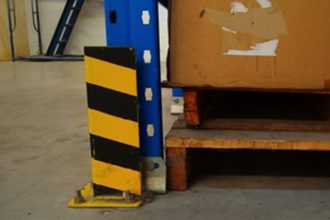What’s Height-To-Depth Ratio, And Why Is It Important?

To significantly minimize the risk of a single row of standard steel storage rack from becoming unstable and overturning due to a seismic event, wind or forklift impact, Section 8.1 of RMI’s ANSI MH16.1-2012: Specification for the Design, Testing and Utilization of Industrial Steel Storage Racks advises evaluating its height-to-depth (HTD) ratio.
In simple terms, the HTD ratio describes the ratio between how tall the rack is compared with how wide it is at its base. A rack that is 10 feet tall and 10 feet wide (a 1-1 HTD Ratio) will be much more stable (less likely to fall over) than a rack that is 10 feet tall and 1 foot wide (a 10-1 HTD ratio). To calculate the HTD ratio, divide the measured height of the pallet rack from the floor to the top surface of the highest load-supporting beam level by the depth of the frame. (The depth should to be measured at floor level, from the outside of the front column to the outside of the back column.)
If the calculated HTD ratio is 6 to 1 (or less), the rack base plates can be secured to the floor with normal anchoring. However, if the HTD ratio exceeds 6 to 1, the anchors and the base plates should be designed to resist an overturning force of 350 pounds applied to the uppermost beam level.
If it is determined that the HTD ratio is greater than 8 to 1, the Specification recommends that racks be stabilized using overhead, or cross-aisle, ties as an additional safety measure. These extend across the aisle to connect two frames together at the top for additional support and to minimize the risk of overturning. (Additionally, when overhead ties are needed, the frame heights are frequently further extended so as to avoid being hit by a load during placement or removal from the top pallet position of the rack.) If anchoring is used for racks of this high ratio, an engineer must certify the anchors’ design.
The HTD ratio specifications apply to both roll-formed and structural rack in a standard, single-row configuration (not back-to-back). Racks in a back-to-back configuration require the proper type and quantity of row spacers to secure the two frames together. If unsure, contact an engineer. A rack system designed with sloping or offset legs are subject to different engineering calculations and analysis. Slope leg or offset leg frames are not to be used in a single row application without an engineer certifying the design.
Looking for more insight into rack specifications? Download a copy of ANSI MH16.1-2012: Specification for the Design, Testing and Utilization of Industrial Steel Storage Racks.


